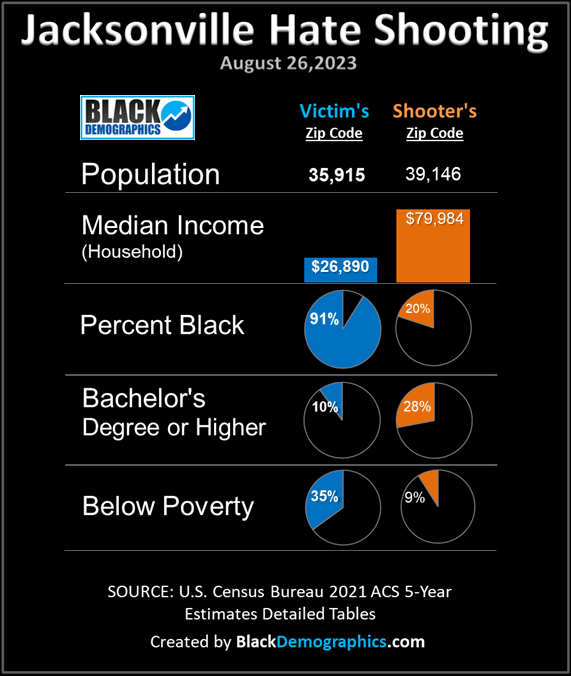Comparative Analysis: Shooter’s Zip Code versus Victim’s Zip Code
On August 26th, 2023, a deeply troubling incident unfolded. A man, possibly influenced by the conspiracy theory known as “the great replacement,” and although he may have suffered from mental illness, seized upon a growing and hateful ideology that has been gaining prominence on social media. He made the calculated decision to drive 25 miles from his affluent suburban area into a predominantly Black neighborhood. His choice of this particular area was no accident: the stark contrast between his origin and his chosen destination illustrates a profound socioeconomic divide. The irony cannot be overlooked: someone from a place of privilege, perhaps fearing being “replaced,” lashed out at those in a community who are economically and educationally disadvantaged.
Demographic and Socioeconomic Disparities:
- Population Metrics: Both the victim’s and the shooter’s zip codes have comparable total populations, with the victim’s area home to 35,915 residents and the shooter’s area accommodating 39,146.
- Racial Composition: The racial landscape is markedly different. While the victim’s zip code is overwhelmingly Black or African American at 91%, the shooter’s zip code is only 20% Black. This racial disparity potentially influenced the shooter’s targeted aggression towards the predominantly Black community.
- Educational Attainment: Education often acts as a proxy for opportunity and access to resources. The shooter’s zip code boasts a higher percentage of residents with a Bachelor’s degree or higher, standing at 28%. In contrast, only 10% of residents in the victim’s zip code have achieved this level of education.
- Economic Metrics: The economic disparities are glaring. The median individual income in the shooter’s zip code is a robust $79,984, almost triple that of the victim’s zip code, which stands at a modest $26,890. Moreover, the victim’s zip code sees a significant 35% of its residents living below the poverty line, juxtaposed with just 9% in the shooter’s zip code.
Conclusion:
Although the manifesto has not yet been released, the killer’s potential adherence to “the great replacement” theory is bitterly ironic. Here was a young man from a zip code with undeniable privilege in terms of education and income, who chose to act upon a conspiracy theory and a virulent ideology prevalent on digital platforms. It’s crucial to recognize that while individual factors like mental health might play a role in such actions, they do not exist in a vacuum. The amplification of hate through online channels, combined with demographic and socioeconomic disparities, paints a complex and somber picture. By sharing these disparities, we aim to highlight the broader societal issues that intersect with racial prejudice and conspiracy-driven ideologies, underscoring the need for a more comprehensive approach to bridging these divides and preventing such tragedies in the future.



